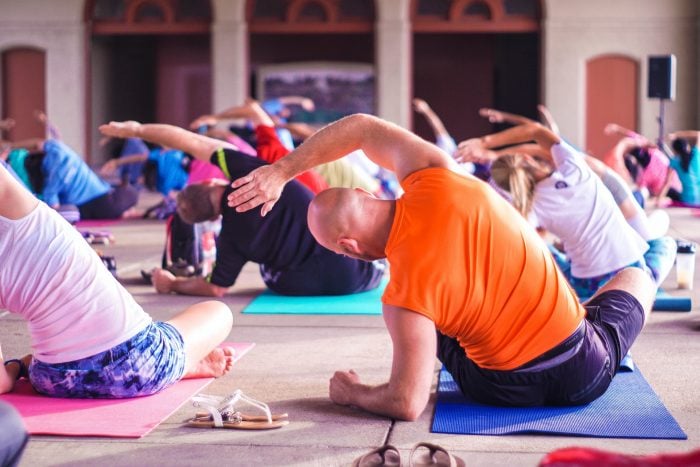“Let go of expectations” is a gentle command that I struggled to follow in my early years as a yoga student.
I struggled because I feared that to lose expectations would mean to lose motivation.
Why would I invest my energy in a practice that I didn’t expect to gain benefits from?
But there was a problem in holding onto expectations. I put pressure on myself to achieve certain goals, such as developing a just-right posture, even when my body wasn’t quite ready.
Expectations became a standard to which I held myself tightly accountable, and this tight self-control produced more tension and stress, rather than less.
In addition, when I focused on a desired future result, I ended up missing out on my yoga experience in the present. Instead of being at one with my actual body, I became caught up with making a better one.
Over time, I learned to take steps to shift my perspective. I became more skilled at letting go of expected outcomes and being open to the here and now.
Expectations are fine if we hold them lightly. Here are three steps to take if you have an iron grip on yours:
1. Bring Compassion and Curiosity.
Rigid expectations don’t soften if we judge or resist them. For example, if we discover in our yoga practice a perfectionist expectation to achieve a just-right posture, the perfectionism will not go away by fighting against it or shaming ourselves for having it.
What works better is to show a little compassion for ourselves. We can interrupt our negative self-talk about pushing too hard and pause for a moment in silent acceptance of our tendency.
We can show ourselves appreciation for having high expectations, recognizing that they have helped us achieve a lot of good things. We can let the breeze of the breath soften our expectations’ harsh edges.
Part of bringing compassion is bringing curiosity.
We can ask ourselves why we are so pushy with ourselves. Why in yoga, for example, do we strive hard to perform poses the way the teacher models them instead of allowing ourselves to experience our own personal unfolding of the poses?
Perhaps the issue is that we have fully bought into a lesson from our early years: if we want to get somewhere in life, we better aim really high and not rest until we get there. Perhaps we have been hooked by other people’s negative judgments about our looks, our capacities, or our future prospects, and we have set out to prove them wrong.
Compassionate curiosity is a gentle kind of self-investigation. It can uncover blindspots in our view of the expectations that drive us. With more openness and awareness, we have more choice.
Do we really have to be governed by rigid expectations that may have emerged years ago?
2. Shift from expectations to intentions.
Expectations are beliefs about what will or should happen in the future. They are necessary in planning and preparing for life changes. But we don’t want to be future-oriented all the time. We want to be able to stop and smell the roses. And we want to be able to focus and pay full attention to what we are doing as we are doing it.
I’m almost 69, and I have expectations that yoga will help me to move with relative ease and balance as I age. But if I’m focusing on what I’m expecting to gain from yoga in the future, I’m going to miss out on my experience actually doing yoga.
A good way to keep expectations from cluttering up the present is to focus on intentions. An intention is about the qualities of heart and spirit and frames of mind that we offer to our practice, such as awareness, openness, and a spirit of exploration and discovery.
Intentions aren’t about what we will achieve through yoga. They are about what we will experience with yoga.
At times, I set an intention to be more playful. Lately, for example, I’ve intended to embody in certain poses the form and movement of their animal namesakes. For example, in Down Dog, while keeping my pelvis stretched back and stable, I’ve been wagging my tailbone. This produces a warm, rising, pleasing energy in my core.
In my regular life, I’ve also tried to shift from expectations to intentions. For example, as a volunteer English-language tutor for immigrants to this country, I’ve had to learn to focus less on my expectation for pats on the back from the individuals I serve and more on my intention to support them in their learning.
3. Be open to the harmony of alignment without expecting it.
Alignment is a central focus of the yoga I practice. In a nutshell, alignment is a natural ordering of the body with gravity and within itself.
When I stand upright on all corners of my feet, for example, neither leaning forward on my toes nor backward on my heels, I’m letting gravity center me. Similarly, when I experience the full and smooth length of my spine while honoring its natural curves, I feel both stable and agile.
When I’m aligned, I’m at once grounded and free.
I used to set an expectation to achieve alignment and feel harmony. I’d say to myself something like, “Today, I’m going to make my spine look like the long but gracefully curving spine I see in my yoga anatomy book. And this, I’m pretty sure, will put me in a state of flow.”
But these expectations did not lead to any sense of harmony. They led me to yank my body into a shape that didn’t feel quite me or quite right. For example, I knew my head was supposed to be centered over my neck and shoulders, so I would vigorously pull my head back to compensate for a tendency to tilt it forward. Yet this caused me to jut out my ribs and tilt my rib cage backward.
What works better for me is to view alignment as something that is already there within me, rather than something I expect to produce.
My task is to open to this alignment, not to struggle to attain it.
Letting myself ride the natural wave of my breath along the length of my spine is a key source of alignment. But I don’t set achievement expectations for my breath. This would be a bit like setting achievement expectations for the ocean. Sure, I can guide my breath to soften tension in different parts of my body or to help me restore calmness. But this is more about bringing awareness and attention to the breath in the present moment than about expecting it to yield a future result.
Perhaps a parallel to this kind of openness without expectation is what I’m sensing as I write this article. If I focus on the impact I’m hoping to have with readers, I get distracted from the actual process of writing. If I get caught up with performance expectations, I distance myself from the authentic experience and personal voice that want to show up.
In yoga and in life, when we can loosen the grip of tight expectations, we become more at home with who we are and what we are experiencing in the present.
~











Read 5 comments and reply